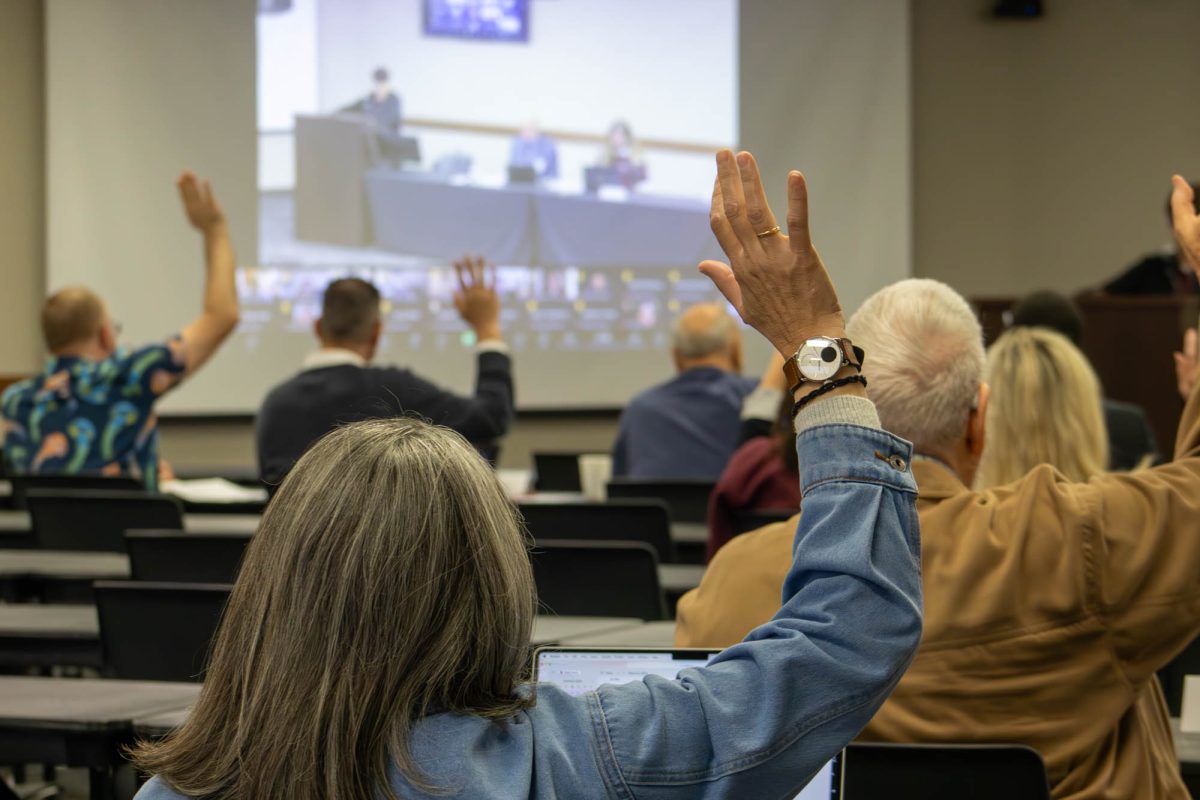Texas A&M looks to enter its “Decade of Excellence” after Interim President Mark A. Welsh III shared the university’s new vision and its strategic plan.
On Wednesday, Nov. 28, Welsh III delivered his first State of the University address at Rudder Theatre. Welsh delivered his presentation to students, faculty and community members. Unlike past addresses, Welsh opted not to speak behind a podium to connect more with attendees, he said afterward.
Between now and 2025, Welsh said A&M aims to act on six priorities: transforming education and student success, improving graduate and professional student education, research, growing faculty, becoming a “best place” to live, work and learn, along with engaging Texas and beyond.
Beyond 2025, Welsh’s vision for 2030 is built upon uniting A&M’s community to change the state, nation and world through transformational education, along with encouraging discovery and innovation.
“The most important thing about this [vision] and that road, the only real requirement to be successful is that we walked down this road together,” Welsh said. “We have a map already.”
In January, A&M will begin two studies on students’ experience and campus capacity, which will identify issues that affect students and faculty. Both studies will be due by the end of June 2024.
Welsh said A&M’s biggest priority is to establish the “right size” of faculty and staff to meet students’ needs, along with creating a target student enrollment. A&M has expanded rapidly in recent years, and College Station’s campus has over 77,490 students enrolled, which is the largest population in the nation.
Since stepping into his role in July, Welsh has met with students and faculty to hear concerns for specific areas of university improvement. In October, Welsh reviewed recommendations from Aggies and a separate task force, then presented his final decisions to push A&M forward despite several nationally-publicized controversies in the summer following the failed hiring of prospective journalism director Kathleen McElroy.
Welsh said the university hopes to re-enter the national conversation for positive reasons, and A&M will further invest in its strengths to offer a No. 1 education and student experience. In recent rankings, A&M was named the No. 1 public university in Texas and No. 6 in the nation, according to the Wall Street Journal. Rankings from the U.S. News and World Report named A&M as the 20th best public university in the nation.
“You can kick the door down to get into the top 20,” Welsh said. “It’s hard to ignore 77,500 students and a billion dollars in research expenditures. It’s just hard to ignore that. But [the difference] from 20 to one is mostly reputational.”
Due to a lack of transparency during the summer, Welsh said many people didn’t understand what was happening or why. The controversies created major concerns about how to improve A&M’s diminished reputation and communication in a way that aligns with A&M’s Core Values, Welsh said.
“It felt divided just about everywhere I went on campus, but there was this underlying desire to get back on track,” Welsh said. “You could feel it, people expressed it, you could see it when they came into the conversation. They just wanted to get back to being who we know we can be — and should be — and really who we are every day. It just wasn’t what was happening at that point in time.”
Welsh said there were concerns regarding a lack of academic freedom and shared governance, which led to the disruption of department programs and systems, such as the university libraries having their funding cut. Welsh said there was widespread confusion in many areas about administrative operations and how funding was being prioritized under an unclear hybrid model.
“There weren’t consistent funding schemes for [project proposals],” Welsh said. “There was no real prioritization scheme across the university as to which one should come first when we had to compete for resources.”
Welsh said the previous budget model didn’t quite feel right, and it had begun to impact students due to stretched budgets.
“On the student side, the impact of the number of years of pretty rapid growth was starting to affect them in a way that they felt,” Welsh said. “They were concerned about the student experience changing in a way that was not good for Texas A&M, or for them individually, and they were pretty vocal about it, as were many of their parents.”
Despite being interim president for only four months, Welsh said things on campus have changed since the summer. Since then, Welsh said A&M has acknowledged its reputational damage and recommitted itself to establishing clear communication across all areas of campus. He said A&M has removed 12 of 22 vice president titles because too many positions overcomplicated who was responsible.
“The problem with too many vice president titles is it makes communication harder, because who do you go to … and who is actually accountable and responsible for issues for events for areas of focus … it was just complicated,” Welsh said. “We’ve tried to streamline that and that helps communication.”
The provost of Academic Affairs has been designated as the No. 2 in charge, so there is a clearer chain of authority, Welsh said.
Welsh also said he has worked closely with the faculty senate to protect academic freedom, created plans of action from feedback provided to the Quick Look assessment and returned more funding to university libraries.
A&M is also changing to an incremental baseline budget model. Welsh said it will use previous years’ budgets as a starting point until the recently-formed Strategic Budget Council decides there is a need to change it. Welsh said A&M is a public university, but it also runs like a large business due to its annual $2.56 billion budget.
“Everybody is competing against everybody else for every dollar … [the university is] all competing with itself,” Welsh said.
The council will hear office leader presentations annually that highlight proposals for new programs, implementing initiatives and hiring faculty or staff. The most important efforts will be prioritized for allocating additional funds.
Similarly, under A&M’s Philanthropy Council, Welsh said A&M hopes to partner more with philanthropic organizations, such affiliate groups like the Texas A&M Foundation, Association of Former Students, 12th Man Foundation, Texas Aggie Corps of Cadets Association and George & Barbara Bush Foundation. Welsh said university partners actively serve Aggies and need to be involved in the discussion.
Concluding his speech, Welsh said his vision cannot be achieved by himself.
“I’m ready to get to work,” Welsh said. “I hope you join me.”










